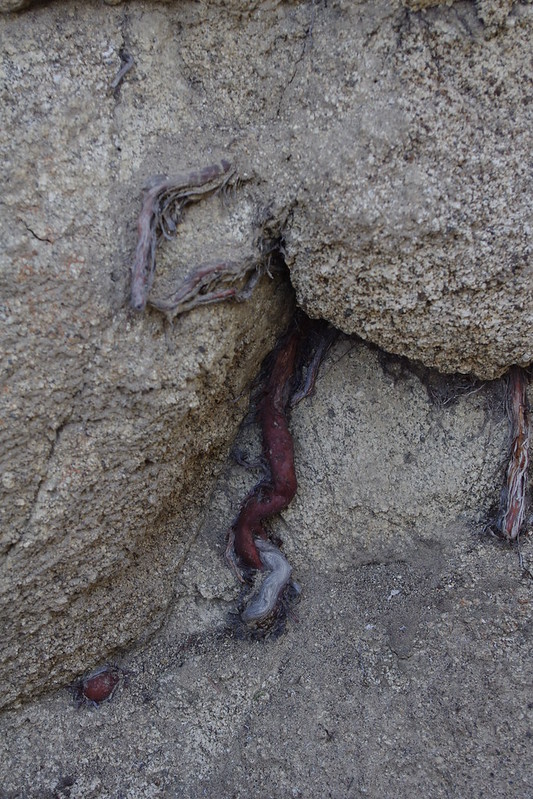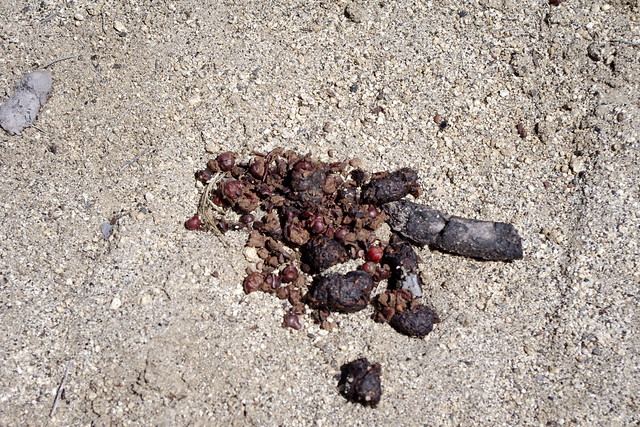We are also including here such other important descriptive terms such as Chaparral Tunnels, Chaparral Caves, Chaparral Hidden Glens
 |
| Image: Californtia Chaparral Institute |
From the very first time I gazed at this photograph, I fell love with it. It's mesmerizing and addicting. You just want to step into this place and escape from the outside world even if it's momentarily. It's one of those poster child pictures which would have been recreated onto one of those 1970s popular wall paper murals with a Lava Lamp sitting on a rustic knotty pine end table as part of the decor. But the tangle of biological plumbing/electrical networked infrastructure of the branches above ground and rooting infrastructure below ground all working with cooperative precision and perform all manner of hydraulic life and redistribution or hydraulic descent during the winter months is just how nature's ecosystems run. People who are clever & intuitive enough to find these old ancient Chaparral Alcoves can experience the exact same energizing natural effects which can be illustrated in a rather unusual way by the re-energizing alcoves that only a mythical Borg could appreciate. Surely you remember the Borg ? However in real life, experiencing the negative ions given off from wet vegetation along with inhaling the various plant aerosols can have exactly that same effect on a human being. It's energizing! Couple that with the informational visual content being transmitted through your eye lens taking in the surrounding beauty [which is the rule in nature & not the exception] and being processed along with all other information coming in through other sense of smell and hearing, the effect can be truly energizing in a real true sense.
Now to the point of this post. I love patterns in Nature, especially artistic natural patterns. I love how they make you feel once you discover and experience them. When I was a little kid, exploring chaparral alcoves and/or tunnels was easier, I was smaller. Gradually I experienced such features near beaches and city parks where the municipal landscapers created such decorative twisting features within their maintained landscapes, but did so with exotic plants. A fine example of this is to visit Pepper Grove at the southern end of Balboa Park in San Diego where they have maintained a twisted grove of Brazilian Pepper trees into a children's playground wonderland and picnic area. Google "Pepper Grove Balboa Park" and you'll see what I mean. Later during the Southern California wet El Nino event period between 1978-1984 many traditionally dry washes and gulches within the chaparral plant community came alive with babbling brooks of water often running all year long. What made me explore some of these when I was out and about in the bush was the distant sound of water trickles and many times small waterfalls. What I noticed was the beauty of the tangled web or network of various chaparral branches. Often such tangle would open up within these hidden glens revealing a secret location where you could even stand. Such places gave me the idea for replicating such hidden spots by recreating them in the landscape. The twisted tree in the photo to the upper right here is at the beach at La Jolla Shores near San Diego.
| Image Mine - San Diego La Jolla Shores, California |
| Carmel-by-the-Sea, California |
| Image Mine: Carmel-by-the-Sea neighborhood |
| Carmel-by-the-Sea, California |
| Carmel-by-the-Sea California |
| Carmel-by-the-Sea Monterey Cypress |
| Laurel Sumac, Rattlesnake Mountain, El Cajon CA |
The photo above was taken this year at my friend's home who lives backed up against Rattlesnake Mountain. This large Laurel Sumac chaparral shrub has been there since the 1960s back when I remember it as a kid growing up. Under normal rainfall patterns which are now almost nonexistent, the foliage is generally much more dense and heavier. But you can see the beautiful branching pattern and structure for a potential addition into any landscape. I had the privilege to witness a volunteer Laurel Sumac at my Mum's places years back before moving here to Sweden. You can it here at the left side yard of her house here. Unfortunately the neighbour at the concrete paved property on the left hated the small chaparral shrub and insisted it was going to turn into massive tree whose roots would crack and destroy his concrete block wall and he warned there would be lawsuits if it wasn't removed. My mother caved [only after I left] and it was taken out. But even from this vantage point, you can see that it poses no problems and at best is only a small tree created by pruning for multi-trunk form. We also never once watered this Chaparral Elfin tree, it was never necessary. All water came from Seasonal rains. Still, this tree is rarely used or thought of for this purpose by even those who purchase natives. This is reflected by the fact that even native plant nurseries rarely carry it. But it's a gem of a chaparral tree when incorporated among other chaparral.
| Image Mine: Ranchita California, Sugarbush (Rhus ovata) |
.jpg) |
| Calflora.net |
Below is a project I am working on each year in the front yard. I'm creating more of a Native Fan Palm Oasis of sorts in the background here away from the driveway with smaller shrubs [some native - others not] to buffer the palms and add colourful border at the front. In the far background behind the palms is a lawn which is coming out and will be replaced by a secret hidden away chaparral alcove which will be slightly etched or excavated into the sloping landscape creating an oval circular arrangement of seating and relaxation under a central planter which will be installed next year and planted with some of the more high desert chaparral to match the Oasis theme better. Believe it or not, SoCal deserts do have Sugarbush, Hollyleaf Cherry and Desert Apricot in and around many of the native California Fan Palm habitats, often growing within or right next to the Fan Palms themselves. If you look to the far right in the photo below, you'll notice a dense hedge of low growing Juniper which my mother put in years ago which screens out the insanity of school traffic across the street multiple times a day. You can also use chaparral in this respect as a formal hedge if you wish, as the example above left of the Lemonade Berry (Rhus integrifiolia) being shaped into formal hedge row. California Coffeeberry can also be used this was as I've written about previously. Surprise yourself by having fun experimenting with other ways of substituting some chaparral plants with unique characteristics you thought only the exotics provided.
| Photo Mine: Across the street from Pepper Drive School in El Cajon California |
| Photo Mine |
| Photo Mine |
 |
| Sunset Gardening landscape pathways |




















